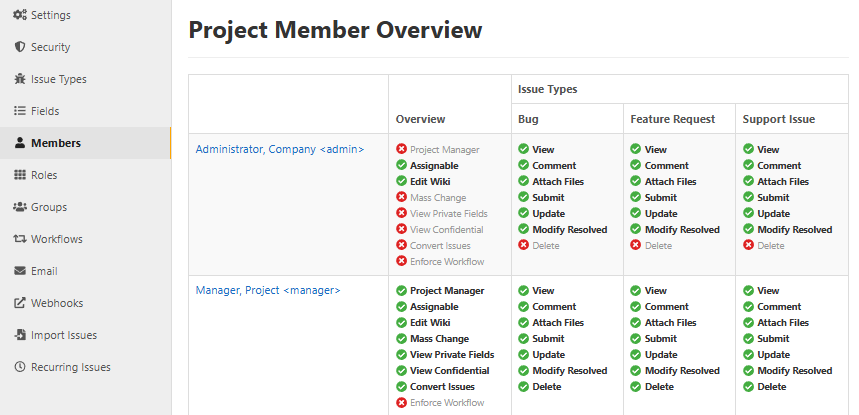Project members are the people on your project team. They are the people who will submit or resolve issues on your project. From a project screen click Admin > Members on the navigation bar to access the Members screen, where all project members are listed with their roles. Project managers add members to the project from the pool of users within their company. Project managers can also remove individual members from the project as necessary.
A project manager can add or remove a member by clicking Admin > Members on the project navigation bar.
Project Members
From this page, you can view a list of company users who are also project members, along with their assigned role(s) and the date of their last activity in Squish.
This list of members is split into two tabs: Project Members and Company Group Members.
- Project Members – this tab shows a list of users who have been individually added to the project or assigned additional groups or roles.
- Company Group Members – This tab shows a list of users who have been granted access to the project by virtue of one of the Company-wide Groups they are assigned to. These members have not had individual roles or groups assigned to them.
You can mark the checkbox(es) next to members, then select the roles which that user(s) should have. After all roles are selected, click Set roles for selected members.
Note that this will remove previously assigned roles from user accounts before adding the selected role(s).
Note: If there are no company users who are active and are not already members of the project, this section will not be displayed.
The search field allows you to search the members list by selecting attributes to filter on or by keying in a full or partial name or word. The search results highlight the keyword entered in the field.
- Filter options include:
- By default all active users with a User Type of Normal are displayed.
- When the user list is displayed after editing a user account, any filter criteria you add will be remembered.

There is a link to See an overview of member permissions. The page this opens has a chart which lists every project member. It details each member's overall permissions, as well as their permissions for each available issue type.

To Add Project Members
- Click on the Add Members button.
- Select one or more company users' names from the Select Users to Add field. The name(s) will appear in a row. You can select as many names as needed.
- Select the role(s) for the user(s) by checking the boxes next to those roles. Descriptions added to the role will appear in this list.
- Click the Add Users button.
Note: If you have selected a user by accident you can remove them from the line before clicking the Add Users button by clicking on the X at the right of their name.

Individual Member Screens
You can reach an individual Members screen by clicking on the project Admin menu and clicking on Members. From the Project Members click on a project member name.
 A permissions table displays the member's permissions to perform actions for each issue type. You can change the roles that a member has by checking and unchecking the boxes next to the roles in the Roles field. You may also add or remove group membership for the user. Click Update Member when finished.
A permissions table displays the member's permissions to perform actions for each issue type. You can change the roles that a member has by checking and unchecking the boxes next to the roles in the Roles field. You may also add or remove group membership for the user. Click Update Member when finished.
Additionally, a Member History button is available. Clicking this button will open a chronological, printable list of historical changes made to this member’s project membership. This includes when the member was created, additions and removals of roles to the member, and changes to group membership. Group membership history changes capture both Company Group membership and Project Group membership changes that affected the member’s account.
To Remove Project Members
- Click the checkbox next to the members you would like to remove.
- Click the Remove Selected Members button.
- Click the OK button on the dialog box to confirm.
- If the user has any issues assigned to them, another page will open notifying you of the number of issues assigned to them. You may select a new user to assign those issues to or select the option to reassign those issues to no one.